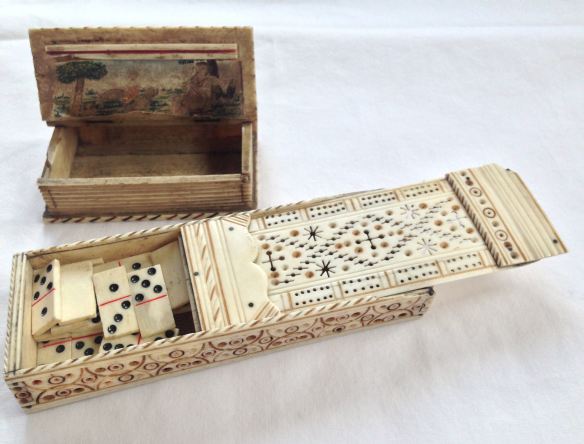
The study of history often seems to be a continuous review of one long war after another. Indeed the story of national endeavor and expansion is enwrapped in struggle and conflict. It is no wonder that the relics of these conflicts carry drama and intrigue like little else in the world of antiques. The articles have value far beyond their age and rarity, intimately tied to patriotism, sense of self, and often the gravitas of personal or family sacrifice.
Military artifacts and memorabilia comprise a varied and fascinating part of the antiques marketplace. Interest ranges from the uniforms and gear found in Army-Navy Surplus stores (and what little boy doesn’t flip over That Aladdin’s Cave?), to the munitions, insignia, medals, and rarities that feature in specialist auctions. Prisoner-of-war hand crafted folk art is particularly fascinating and poignant.

And then there’s vintage spy paraphernalia! Yes, James Bond’s Q Division existed… or rather the more prosaic Office of Research and Development of the OSS. They, and all their counterparts around the world, produced a wealth of sometimes clever sometimes crazy inventions in the name of intelligence. The majority of these comprise various surveillance devices such as miniature or hidden cameras, or electronic bugs. But actual historic spy gear (or tradecraft in CIA lingo) includes disguised encoding and decoding instruments, esoteric weapons (such as a lipstick gun and a pipe pistol), covert exploding devices, camouflaged poison capsules, hidden compartments (yes Maxwell, even in shoes), and even spy drones (including a robotic dragonfly and a remote controlled fish)! And you thought your tax dollars were being wasted.

A great collection of these devices and documents, focusing especially on the cold war period, can be found in the International Spy Museum in Washington, DC. An even better collection no doubt is held in the CIA Museum; unfortunately the latter is not open to the public, but believe it or not Langley has actually launched a You Tube channel and a website featuring a Flickr stream showing some of its museum artifacts. For those who prefer a more personal, hands-on experience, spy gear actually comes up for auction. In fact while I was in London this winter, Bonhams Auction offered a collection of vintage spy technology.
My favorite relic of espionage, the coolest undercover device ever, has got to be the World War II Monopoly game. Yes, that Monopoly game.
As the war progressed more and more allied airmen were being held prisoner in the Stalag camps throughout Europe (German prisoner-of-war camps run by the Luftwaffe air force). In spite of never- ending escape attempts, the soldiers were usually recaptured wandering lost around the countryside before local resistance fighters could come to their aid. The war office saw that maps were desperately needed to aid escape. But how to get them into the hands of the prisoners? And how could they make them durable enough to not tear from repeated folding? Or fall apart when wet? And not compromise the escapees with loud paper rustling noise as they consulted their maps? Someone thought “Why not silk?”
As luck would have it, the English firm of John Waddington Ltd. had just perfected the process of quality printing on silk. The firm was happy to aid the war effort and began printing silk maps detailing escape routes through every part of Germany and Italy where prisoners were held. The maps could be scrunched into a very tiny parcel, and were intended to be hidden in the heels of aviator’s boots.

But Waddington also held the UK licensee from Parker Brothers to manufacture Monopoly. Clever minds went to work and soon there was a highly top secret program making Monopoly sets with an escape map hidden inside one of the playing tokens! Other tokens held a miniature magnetic compass and a two piece metal cutting file. The stacks of fake money actually held quantities of large denomination German, Italian and French currency money. The games were distributed under the Geneva Convention to prisoners of war by fictitious aid organizations. Sounds like an escape plan to me. It is estimated that approximately 35 thousand allied soldiers successfully escaped from Luftwaffe prison camps during the war, and it has been suggested that up to a third of them were aided by their Monopoly games. Proceed Directly to Go indeed.

The security was amazing. A small number of Waddington craftsmen assembled these sets in a clandestine chamber, sworn to a secrecy they kept forever… or until the gambit was declassified in 2007. The soldiers themselves knew to look for an innocent red dot in the Free Parking space on the gameboard which signified a special set, and then to destroy the game after removing the secreted bits in order to prevent the Germans from discovering the ploy. At the end of the war all of the remaining sets were also destroyed, and all involved were sworn to remain mumm to safeguard the Monopoly trick so it could be used again in future conflicts.
While there’s little or no chance of finding one of the actual spy games today, it would still be a fascinating reminder of the intrigue by playing the iconic game on a period World War II Monopoly set. You will never look at a Monopoly set the same way again.
_______________________________________________________________
Please excuse any annoying advertisements that may appear below this. The intrusion is on the part of the hosting cite, and is in no way endorsed by the Antiques Depot.
________________________________________________________________
